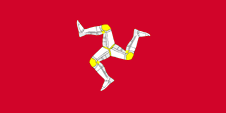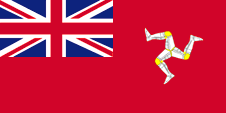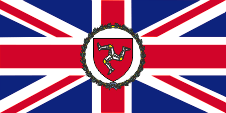mobile View, to the German Version tap the flag


- Isle of Man
- autonomous and by the British Crown administrated territory
• Flags
• Meaning/Origin of the Flag
• Coat of Arms
• Meaning/Origin of the Coat of Arms
• Map
• Numbers and Facts
• History
• Origin of the Country's Name

National flag,
ratio = 1:2,
Source, by: Corel Draw 4






Merchant flag,
ratio = 1:2,
Source, by: Flags of the World




Flag of the Lieutenant Governor,
ratio = 1:2,
Source, by: Wikipedia (DE)




The national flag of the Isle of Man is a single coloured red flag with the symbol of the island laid in its centre. It is a triplagram, a three-armed cross picturing amour covered legs. The name of the flag is "Trinacria". The triplagram is also in use in the flying end of a Red Ensign, the merchant flag, also called the Civil Ensign. This aligns the Isle of man with the British Ensign-System, and, along with the use of the "Union Jack" points to the connexions to United Kingdom. United Kingdom introduced a flag system in 1864 in which:
• war ships fly the "White Ensign" (naval flag), a white flag often with an uninterrupted red St. George's-Cross and with the Union Jack in the upper staff quadrant of the flag,
• merchant ships fly a "Red Ensign" (also named "Civil Ensign" => civil flag, the real merchant flag), a red flag with the Union Jack in the upper staff quadrant of the flag, and
• governmental ships fly the "Blue Ensign" (flag for the use by the gouvernment => the actual state flag), a blue flag with the Union Jack in the upper staff quadrant of the flag.
Since 1865 ships of colonial governments were permitted to fly the Blue Ensign with a badge in the flying end of the flag. The respective governments were asked to design appropriate badges. Merchant ships and seafaring persons from colonies were only permitted to use the Red Ensign with a badge, then also named Civil Ensign, if permission has been given to the respective colony by the British admiralty. The colors are basically subordinated to the correct color representation of the Union Jack and thus correspond to the colors of the flag of the United Kingdom: blue pt 280 c and red pt 186 c.
Source: Die Welt der Flaggen,
Wikipedia (D),
Volker Preuß


Coat of arms of Man,
Source, by:
Wikipedia (DE),
Corel Draw 4

The red coat of arms depicts a triskele formed of three armored legs joined at the hips and bent at the knee. The origin is unclear but probably dates back to the Scottish takeover of the island in 1265. The greater coat of arms shows in addition to a peregrine falcon and a raven as supporters, the country's motto in Latin: "Quocunque Jeceris Stabit", translated into English: "Wherever you throw it, it will stand". The motto alludes to the features of the triskele.
Source: Wikipedia (EN)


Source: Freeware, University of Texas Libraries, modyfied by: Volker Preuß

Area: 221 square miles
Inhabitants: 84.314 (2016)
Density of Population: 382 inh./sq.mi.
Capital: Douglas, 26.997 inh. (2016)
official Language: English
other Languages: Gaelic Manx
Currency: 1 Isle of Man Pound (£) = 100 Pence, 1 Pound Sterling (£) = 100 Pence
Time Zone: Greenwich Meantime = CET – 1 h
Source:
Wikipedia (DE)

ca. 600 B.C. · Celtic settlement
ca. 440 · conversion to Christianity by St. Patrick
ca. 800–900 · Norman incursions
1266 · to Scotland
ca. 1300 · to England
1765 · sold to the British Crown
Source:
Wikipedia (DE)

The name of the Isle of Man derives from the Celtic name of the island, called "Mannin" in Celtic Manx, but is also handed down as "Ellan Vannin". Sometimes it is also called "Mann".
Source: Wikipedia (EN)


![]()













